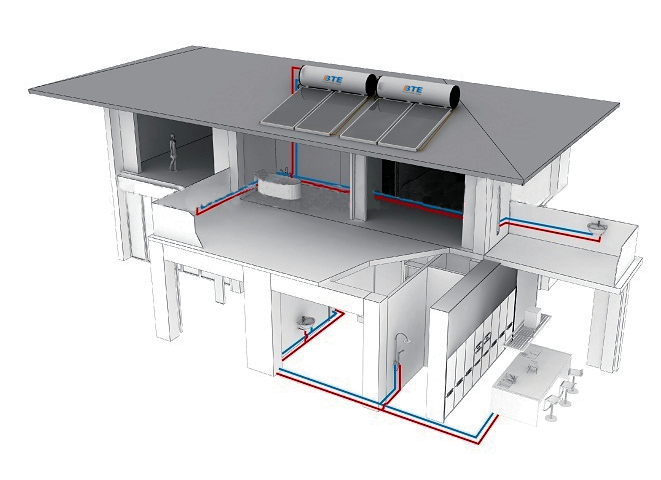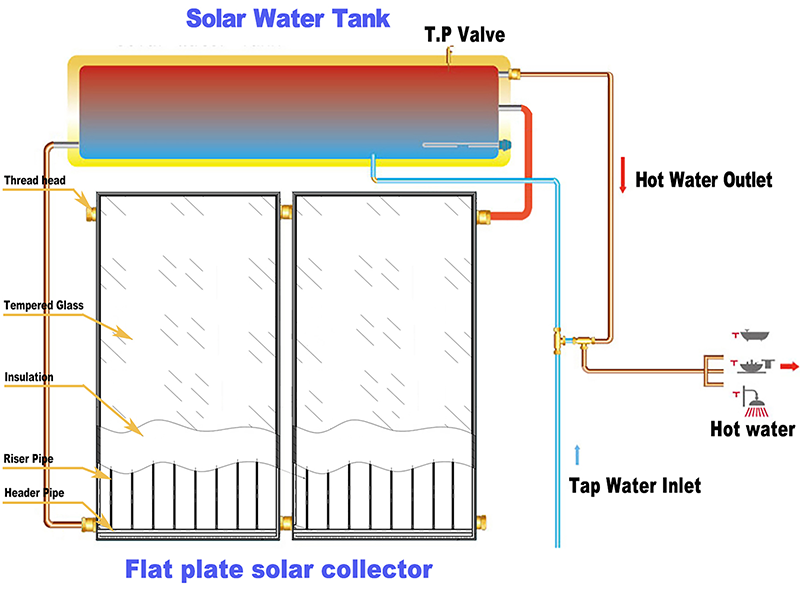A Brief Analysis of the Advantages and Disadvantages of Flat-Plate Solar Water Heaters
A Brief Analysis of the Advantages and Disadvantages of Flat Plate Solar Water Heaters
Flat plate solar water heaters use sunlight that strikes the surface of a collector, passes through a transparent cover, and is projected onto a heat-absorbing plate. The heat generated by solar radiation is efficiently absorbed by a blue or black film coating with high absorptivity and low emissivity, converting it into thermal energy. This energy is then transferred to a heat transfer medium. A flat-plate solar collector consists of four main components: a heat-absorbing plate, a transparent cover, an insulation layer, and an outer shell. A water pump transfers the heated working fluid through a circulating pipe to cool water via a heat exchange coil, continuously raising the water temperature. The heated water is then stored in an insulated water tank.
So what are the advantages and disadvantages of flat-plate solar collectors?
Advantages of Flat-Plate Solar Water Heaters:
1. Flat-plate solar water heaters are ideally suited for building integration. Due to their flat design, flat-plate solar water heaters are not restricted by shape or size, offering flexible design options and making them easier to integrate with building components. Furthermore, their metal collector plates facilitate installation and maintenance.
2. Its thermal efficiency is very high. Unlike vacuum tubes, flat plate solar collectors have no gaps; they are continuous surfaces. When exposed to sunlight, the entire collector surface receives sunlight. Therefore, under the same lighting area and sunlight intensity, the average daily efficiency of flat-plate solar water heaters is over 6% higher than that of vacuum tubes.
3. Flat-plate solar water heaters have excellent pressure resistance. The heat absorbing plate of a flat-plate solar collector is made of metal, and the connection between the collector and the water tank also uses metal parts. Therefore, it can withstand the pressure from tap water and circulation pumps.
4. Its performance is also very stable. In large venues such as hotels, swimming pools, and factories, the use of solar water heaters requires a large number of solar collectors to form a large-scale water supply system. Vacuum tube solar water heaters use rubber and plastic components for connections, which can be very unstable. In contrast, flat-plate solar collectors use metal to connect the collector to the system, which provides very stable system.
Flat-plate solar collector structure diagram:
Disadvantages of flat-plate solar collectors:
1. They are more suitable for use in non-freezing areas, otherwise they may still freeze in winter. Since the core of flat-plate solar panels is not vacuum-filled, even though they are filled with insulation, the insulation is still not very effective. Compared to vacuum tube solar systems, they dissipate heat faster and cooler in winter when outdoor temperatures are lower. While using secondary heating solves the problem of being unusable in winter, it also adds an intermediate step, resulting in some heat loss.
2. They suffer from some heat loss. Since the core of flat-plate solar panels is not vacuum-filled, and combined with the associated equipment, the insulation is not very good, they dissipate heat faster in winter than vacuum tube solar systems.
Operational Schematic Diagram of Flat-Plate Solar Water Heater:
In fact, among solar products integrated with buildings, flat-plate commercial solar water heating systems offer both safety and excellent performance.
While flat-plate solar collectors have significant advantages and disadvantages compared to vacuum tube solar water heating systems, vacuum tube solar water heating systems have drawbacks such as tube bursting and lack of pressure when integrated into high-rise buildings.
Flat-plate solar collectors are the core heat-collecting components of split-type flat-plate solar water heating systems, and their performance directly impacts the energy efficiency of the entire system. Improving the thermal performance of flat-plate solar water heaters not only maximizes solar energy utilization but also increases collector reliability. Thermal insulation and the absorber's absorptivity are two key factors influencing the thermal performance of flat-plate solar collectors. The absorptivity of existing absorber coating materials has generally reached levels above 0.92, leaving limited room for improvement. Therefore, improving the thermal insulation of flat-plate solar collectors is a key factor in enhancing their thermal performance.








